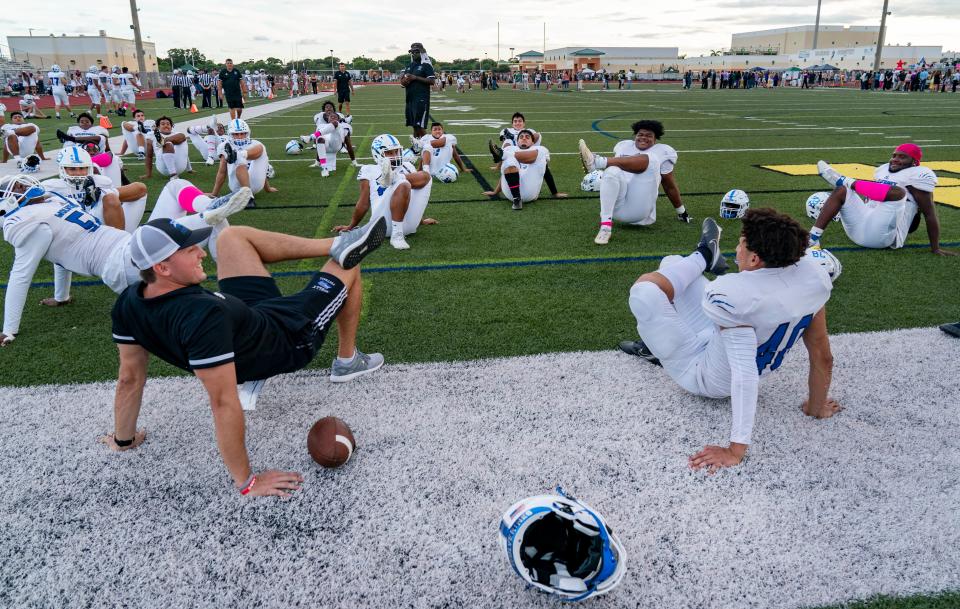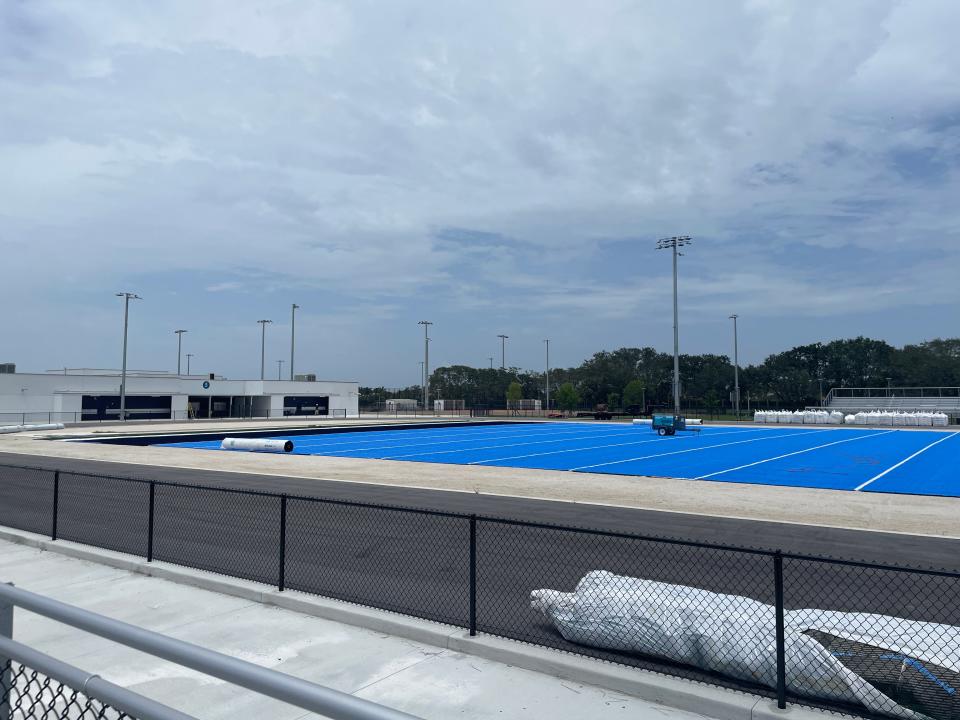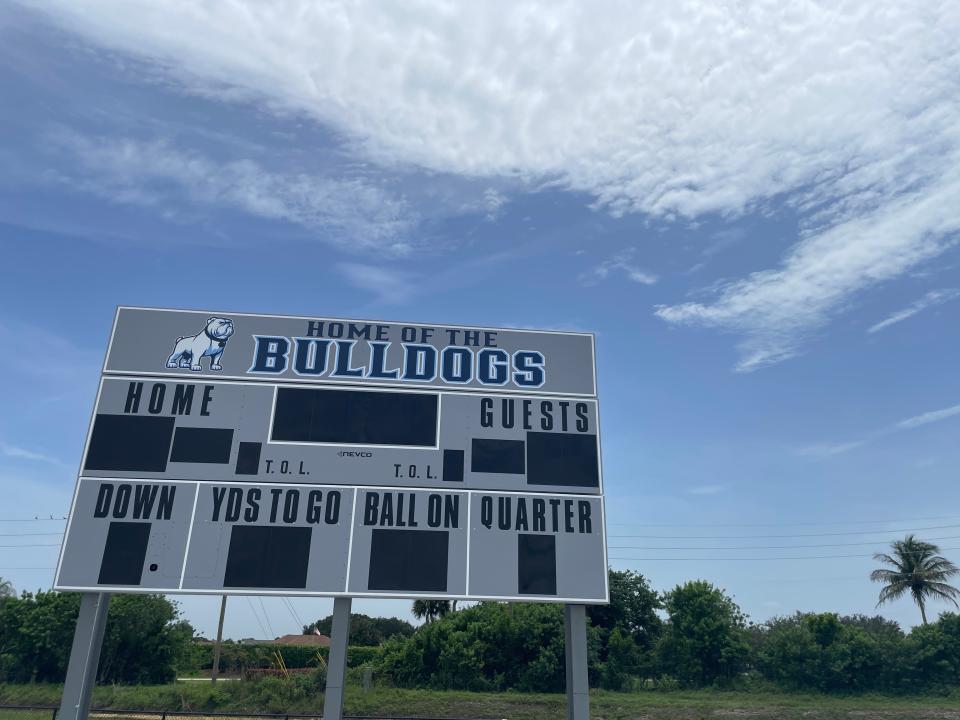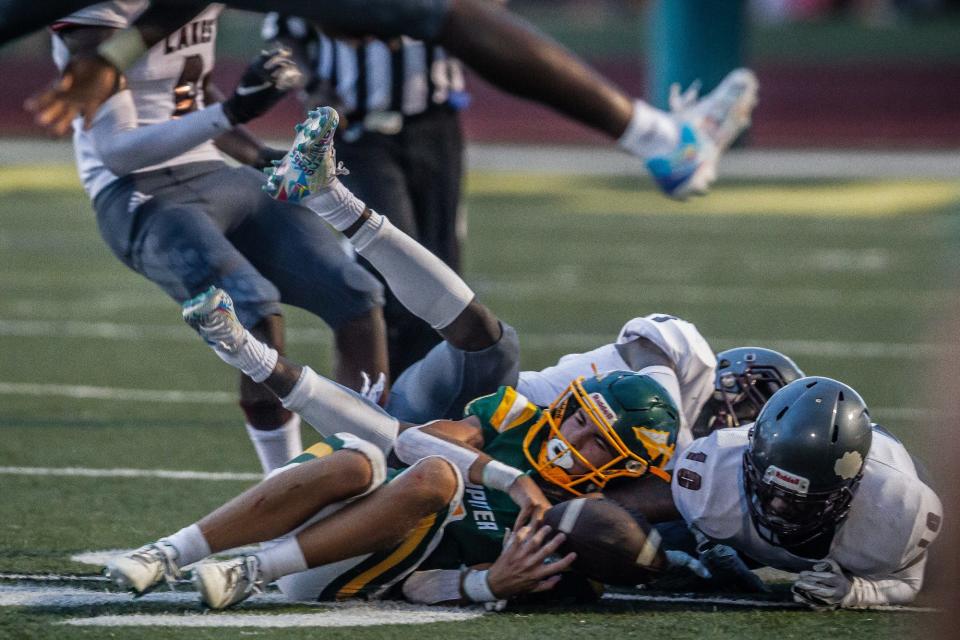Dr. García High football field switched to artificial turf, costing extra $1.4 million
An abrupt change in plans for Palm Beach County's newest high school will result in a new artificial turf football field for nearly $1.4 million. Dr. Joaquín García High School will be just the fourth public high school in the district with a turf field.
But when district staff made the change just six weeks before the football team's home opener, they didn't follow the normal bidding process to keep the price competitive, saying they didn't have time.
Crews from Pirtle Construction were already installing the base for a natural sod football field at Dr. García High, the district's first new high school in 18 years, when the school board approved the artificial turf field Wednesday.
Now construction crews are redoing the irrigation systems, relocating the long-jump and shot-put pits and creating the new blue turf field ahead of the first home football game Sept. 1.
While school and athletic leaders have been speaking publicly about the school's turf field since April, it wasn't until a July meeting of the district's construction oversight committee that the plan officially took shape.
Welcome to the Dog Pound! Dr. Garcia HS will have a blue turf field for football, soccer, and lacrosse.
We will have a full slate of Varsity sports teams next year and are looking forward to competing. pic.twitter.com/68iVvlSae6— Dr. Joaquín García High School (@DrGarciaHS) April 25, 2023
At that meeting, committee members had major concerns that the district did not use its typical competitive bidding process to get the best price for the project. Instead, it issued a "change order" and gave Pirtle Construction nearly $1.4 million to create the field.
"This is a $1.4 million, non-bid, sole source, sole provider (project). And the reason for that is time," committee member John Chesner said before voting against the project. "Why couldn't you go out and get bids from other vendors six months ago?"
Chesner called the whole process "very unusual." He was one of two committee members who voted against the project, which the school board ultimately approved Wednesday.
Asked whether the field will be complete by the start of football season, Joseph Sanches, the district's chief operating officer said he's "very confident" that Dr. García High will have a finished field by the football team's first home game.
"Our goal, should the weather cooperate, is to complete field before the start of school," he said.
School starts Aug. 10.
Palm Beach County school board members approved turf in April. Why didn't the construction start then?

In April, board members agreed to a long-range plan to replace sod football fields with turf at all public high schools.
"Artificial turf fields provide several advantages over grass fields in terms of lower maintenance and much higher availability for the variety of uses of these fields throughout the year," Sanches said.
Instead of installing and then ripping out the sod field in the next five years, district staff told the construction oversight committee that it made sense for Dr. García High to get a turf field from the start.
But turf wasn't included in the original plan for the school, so work on the grass field had already begun, according to school board materials. It typically costs $300,000 for the district to install a natural sod football field, Sanches said. The new turf field will cost three times that.
Like most government agencies, the school district uses competitive bidding on major projects. For purchases of more than $5,000, the district must receive at least three competitive quotes from vendors. For projects that cost more than $50,000, the district must publish a request for proposals and receive sealed bids, according to its own purchasing policy.

No such process took place with the turf field.
And Michael Gelfand, a member of the construction oversight committee, told district staff in July that "doesn't work" with the district's standards of transparency. Another committee member pointed out that an estimate for irrigation of the turf football field was dated in February, although the change order wasn't issued until July.
Sanches defended the approach.
"Artificial turf fields require design, permitting and construction, which takes a significant amount of time," he said. "The district's project team worked with the vendor who successfully designed and built our other artificial turf fields, And the price was scrutinized and validated by our construction manager, architect, engineer and program manager."
Boca, Jupiter and Wellington high schools already have turf fields

Only three public high schools have artificial turf fields: Boca Raton High, Jupiter High and Wellington High.
The three schools' enhanced fields came in handy in 2020 when the school district was tasked with stacking football games back-to-back during a season abbreviated by the COVID-19 pandemic.
Four football games involving eight teams were played in the course of just 27 hours each weekend: a game at 6 p.m. on Friday, then one at 10 a.m., 2 p.m. and 6 p.m. on Saturday.
“If we were to do that on a natural grass field, there wouldn’t be much grass left by the time we got done with the first Saturday game,” district athletic manager Valerie Miyares said at the time.
One reason the school board has since decided to install turf throughout the district is so their facilities can compete with charter schools and private schools.
Enrollment at private schools is likely to climb in the coming years due to Florida's expanded voucher program.
"This gives us the opportunity to compete with private and charter schools as well," Sanches said at a July meeting of the district's construction oversight and review committee.
What about safety and heat concerns with artificial turf fields?

Players, coaches and athletic trainers have long debated whether artificial turf or grass is safer to play on, citing concerns about ACL injuries and heat on the field.
At the high school level, a team of physician researchers in Ohio found that athletes were 58% more likely to sustain an injury during workouts on artificial turf than they were on grass. Injury rates were highest for football, girls and boys soccer and rugby athletes, according to Dr. James Voos, who authored the study.
The data were collected by researchers from University Hospitals, Case Western Reserve University and the University Hospitals Sports Medicine Institute during the 2017-2018 season. The 953 injury reports came from 26 athletic trainers across high schools in Ohio.
At the professional level, the NFL players' union has found that grass football fields are "significantly safer" than turf by analyzing noncontact injuries to players' legs, knees and ankles. While injury rates on the surfaces narrowed to nearly the same in 2021, the differences became more stark during the 2022 season, according to reporting by ESPN.
At the same time, artificial turf fields generally get hotter than natural grass fields, researchers have found. For players in Palm Beach County, temperatures reach well in to the 80s during the first half of the football season, which starts on Sept. 1 this year.
Since grass naturally releases water vapor, grass fields are self-cooling and "rarely get above 100 degrees," according to the National Recreation and Park Association. But researchers at Penn State University’s Center for Sports Surface Research found in 2011 that surface temperatures on turf fields can exceed 150 degrees during the day due to synthetic materials used to infill the turf field.
But district staff point out that few high school football games or soccer matches take place during the hottest hours of the day, meaning the artificial fields will have a chance to cool off before kickoff.
In addition, artificial fields can drain quickly and not create muddy messes for athletes after a typical South Florida rainstorm.
Katherine Kokal is a journalist covering education at The Palm Beach Post. You can reach her at kkokal@pbpost.com. Help support our work, subscribe today!
This article originally appeared on Palm Beach Post: New Palm Beach County school with artificial grass turf. Is it safe?

